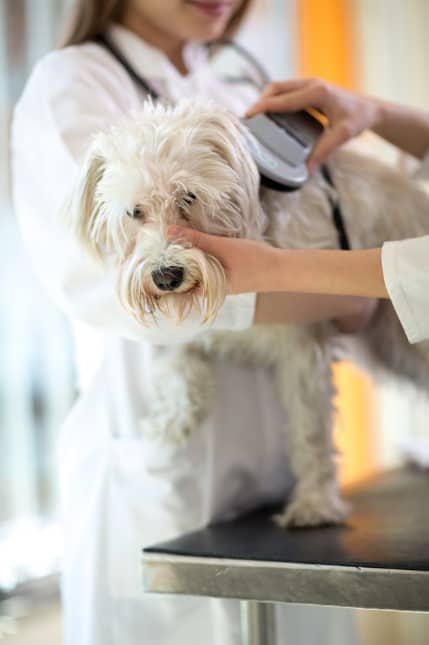It’s a story many of us might be familiar with. Our four-legged friend has somehow managed to clear a perimeter fence and escape the confines of our home, and is now wandering around freely in public. It’s a pet parent’s worst nightmare. Even worse, imagine if your dog’s collar falls off in the process, losing the precious contact information contained on their identification tag. Reuniting owner and pet becomes an increasingly difficult prospect.
This traumatic experience is more common than you might think. The American Humane Association estimates that over ten million pets are lost in the United States every year, increasing the shelter population and causing enormous heartbreak for families across the country.
One back-up option for dog owners is to get their pup microchipped. In the event that your dog is lost and ends up taken in by a shelter, the contact information stored on these microchips can be scanned by the staff at the shelter and help to reunite you with your dog. Although a microchip is not a replacement for a collar and ID tag, it can offer additional peace of mind for dog owners.
June is designated as National Microchipping Month, so we wanted to answer some frequently asked questions about the microchipping process and what it entails.
What is a microchip?
A microchip is a small radio-frequency identification transponder about the size of a grain of rice – approximately 12mm (0.47 inches). The microchip contains a registration number and the telephone number of the registry for that brand of chip. A veterinarian or animal shelter can scan the microchip, contact the registry, who can identify the owner and provide their contact details.
Remember that a microchip is not a GPS tracker. The microchip is used to verify the ownership details of the animal – it does not tell you where the animal is if it is lost.
Where is a microchip placed on a dog?
The microchip is inserted between the dog’s shoulder blades, just under the skin. The procedure itself takes a matter of seconds and does not require your dog to be anaesthetized; inserting the microchip is similar to many other injections or vaccinations your dog may receive.
How much does it cost to microchip a dog?
There is no set price for microchipping your dog, although on average, it should cost around $40-$50. Contact your veterinarian to find out more information.

How long does a microchip last?
Typically, a microchip is designed to last between 20-25 years, which should cover the lifetime of your dog. The microchip has no power supply or batteries, and does not require any level of care after it has been placed inside your dog.
How can you tell if a dog has a microchip?
If you adopt a dog from a shelter, the staff should have a universal scanner which will tell you if the animal is microchipped. If you locate a missing dog, you can often take it to a rescue or veterinarian who will be able to help reunite the dog with its owner by scanning for a microchip.
Are there any risks attached to microchipping?
Although there have been anecdotal stories of side effects, no wide-scale, scientifically-backed study has taken place to verify the likelihood of microchips having an adverse effect on canine health and wellbeing. As this article from The Bark notes, studies have taken place in rodents with no clear findings, and there is no legitimate evidence that microchipping has a clear, undeniable link to disease or illness.
As with any procedure involving your pet, it is always best to do your own research and weigh up the pros and cons before reaching a decision. If you decide to get your pet microchipped, make sure you use a veterinarian or professional you trust.
The importance of registration
Well-intentioned dog owners may think that the process begins and ends with taking their pet to their vet and getting the microchip inserted. This overlooks the most important stage of the microchip process.
It is imperative that you complete the accompanying paperwork to register the chip with the microchip company. This can be a physical paper form, although many companies now offer owners the opportunity to fill in the information online. You will need to provide as much contact information as possible – including name, address, telephone numbers and email addresses.

If your contact details change – for example, if you decide to move home or you obtain a different phone number – make sure to update the registration information held by the microchip company. If your pet goes missing, it will be of no benefit to have them microchipped and registered but nobody can get in contact to reunite the two of you!
When you adopt a dog from a rescue shelter, check to see if it is already microchipped. You can then contact the chip manufacturer and update the contact details so you can be notified if it goes missing.
The benefits of microchipping your dog
Several studies and statistics point to the benefits of getting your dog microchipped.
A 2009 study published in the Journal of the American Veterinary Medical Association found that the return-to-owner rate for dogs with microchips was 2.5 times higher than dogs without microchips.
AKC Reunite reports that “…pets with microchips are up to 20 times more likely to be reunited with their owners.”
Many countries – including all European Union nations, but an increasing number around the world – now require animals to be microchipped before they will permit entry. PetTravel has a helpful list of countries requiring a microchip for pet travel. Without one, your dog may be placed in quarantine or even have to return to its country of origin.

Finally, whilst the best form of identification for your dog is a collar and ID tag (and the microchip is supposed to be an accompaniment, not a replacement for these), these can fall off or become illegible with time.
The microchip is simply an additional measure of protection if the unthinkable happens, and your dog escapes or runs loose.


You must be logged in to post a comment.